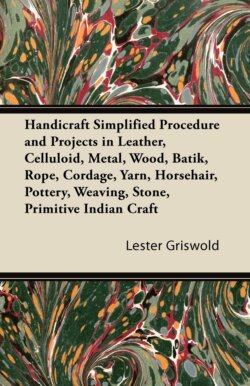Читать книгу Handicraft Simplified Procedure and Projects in Leather, Celluloid, Metal, Wood, Batik, Rope, Cordage, Yarn, Horsehair, Pottery, Weaving, Stone, Primitive Indian Craft - Lester Griswold - Страница 37
На сайте Литреса книга снята с продажи.
Tool Making in Camp
ОглавлениеWhere bench vises are not obtainable the stamping tools may be made by using a short length of log or piece of firewood, and a pair of pliers. Sketches 1A, 1B and 1C indicate the use of a piece of timber to hold the spike from which the stamping tools are made.
Stamping tools may be constructed out of 16 or 20 penny nails, and the designs illustrated have been selected since they may be constructed with comparative ease.
The necessary tools required for making tools of the designs illustrated are a few files, one 10 or 12 inch bastard and some jewelers’ needle files (ask for No. 4 cut, round handle needle files), a rat tail or round file also a square file, and a three sided taper file, called a three square. For making stippled background tools and rosettes a center punch and hammer are also required.
Fig. 4
The sketches, series 3, 4, 5, 6 and 7 show the procedure in making up the three dot, star, basket weave, horseshoe and pine tree stamping tools. Sketches 2A and B indicate the shape of the nail which has had its head cut off, and in 2B it is slightly flattened. The flattened nail is center punch pricked as shown in sketch 1D and finished by filing as indicated in sketches 3A and 3B.
Stamping tools for use on Metal—Silver, copper, etc.—must be made of tool steel and tempered. See pages 365 and 366.
A simple snap fastener tool is shown in sketch 17 A, B, C, which may be made from an 80 penny nail and a short length of thin strap iron. The use of these tools is shown on page 78.
A good beveler may be made from a piece of drill rod or a nut pick and shaped by hammering and filing as shown in sketches 9A to 9D. Fig. 4. It is not necessary to use a vise. Drive the stock from which a beveler or creaser is made into a log to hold it securely. These tools may be shaped by holding them in the hand firmly against a notched block—sketch 9A, attached to the work bench. The stock may thus be tilted so that it can be filed in different positions as shown in 9B. Sketch 9C shows the beveler shape after filing and before it has been tapped with the mallet to give it a slight bend. The bent tool is shown in sketch 9D. Fig. 4.
A good Creaser may be made out of a nail by hammering and filing it to shape as indicated by sketches 8A to 8E. Sketch 8A shows a cut with a taper file, 8B shows the edges slightly rounded, 8C shows the rounding out of the V notch, and 8D the appearance of the finished tool, front and side view. (See Fig. 4.)
An excellent creaser may be made out of hard wood by filing as shown in sketch 10A and 10B. A V notch and a round groove are made in the upper end and the lower edge is tapered to a rounded edge to form a single creaser. Sketches 10C, D, E illustrate the use of the creaser for narrow and wide crease, while 10F and G indicates its use in making a single creased line.
Excellent Tracing Tools may be constructed out of knitting needles, ice picks, nut picks, scratch awls, or any piece of metal having a long taper and a rounded point. Modeling tools may also be constructed out of pieces of tool steel.
Stippled background tools and the center of the star or rosette stamping tools are made with the center punch. When making the center punch impressions in the end of a nail held in a vise, the hammering on the punch will cause the vise to vibrate, and make it difficult to put the punch marks in the proper place. This condition may be overcome by putting a board about 1/4″ longer than the distance between the vise (at a point directly beneath the jaws) and the floor. This board is placed under the vise, and wedged tightly by moving the bottom of it toward the table. This board or prop will take the shock of the hammer blows, and the nail will be held securely and without vibration. Fig. 5. After making the center punch marks in the desired places, file nail away until a thin wall is left around the center punch impressions. The triangular jewelers’ file (three square) is handy for rounding the walls around the one dot and three dot background tools illustrated in Fig. 2A (4-5), also in Fig. 2-L, which shows a rosette stamping tool.
